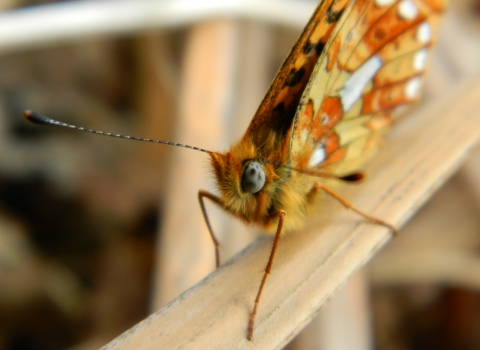
Pearl-bordered Fritillary ©Tamasine Stretton
©Philip Precey
Pearl-bordered fritillary
The pearl-bordered fritillary is a striking orange-and-black butterfly of sunny woodland rides and clearings. It gets its name from the row of 'pearls' on the underside of its hindwings.
Scientific name
Boloria euphrosyneWhen to see
April to AugustSpecies information
Statistics
Wingspan: 3.8-4.7cmProtected in the UK under the Wildlife and Countryside Act, 1981. Priority Species under the UK Post-2010 Biodiversity Framework.
Habitats
About
The pearl-bordered fritillary is a striking orange-and-black butterfly, often seen flying close to the ground along sunny woodland rides or feeding on spring flowers such as common dog-violet. It can also be found in habitats with a mosaic of grass, bracken and scrub. It is the earliest fritillary to emerge in April and may even have a second brood if the weather is good. The female lays single eggs in bracken or leaf litter close to violets, the foodplant of the caterpillars.How to identify
The pearl-bordered fritillary is an orange butterfly with black marks on the upperside of the wings. It has black-and-silver markings on its underside, along with a row of white 'pearls' on the outer edge of the wing. It can be confused with the small pearl-bordered fritillary, which is similar in size and appearance. They are most easily distinguished by their undersides - each has a row of seven pearls on the outer edge of the wing, but the pearl-bordered fritillary exhibits two very distinct additional pearls (one in the centre of the wing, one close to the body), while the small pearl-bordered fritillary has a colourful mosaic of white, orange and brown markings.Distribution
Found in scattered locations in southern England, Wales and Scotland.In our area
Montgomeryshire is home to the strongest remaining population of this rare butterfly in the whole of Wales. For over 20 years, Montgomeryshire Wildlife Trust has been working to safeguard the future of this species. For more information and to watch our film, narrated by Iolo Williams, click here.
Did you know?
Caterpillars overwinter wrapped in a leaf at the base of a foodplant; when they emerge, they are half the size they were the previous summer.Montgomeryshire is home to the strongest remaining population of this rare butterfly in the whole of Wales. For over 20 years, Montgomeryshire Wildlife Trust has been working to safeguard the future of this species. For more information and to watch our film, narrated by Iolo Williams, click here.

